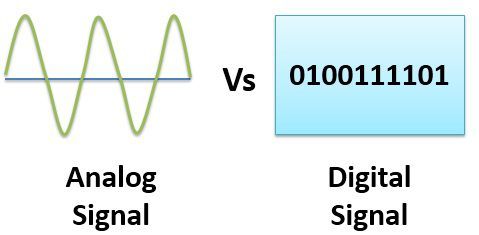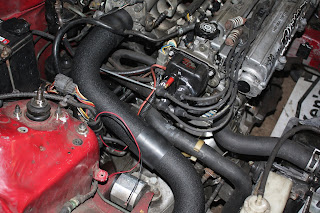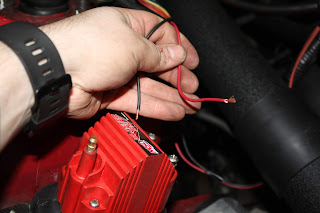Honda made some of the best cars from the late 80s to early 00s with double wishbone suspension, light-weight chassis, lots of cargo room, optional VTEC motors, and low price tags. These aspects and other things contributed to the success of these cars on track and help explain why they are still so commonly seen at track day and road racing events in North America.
However, when subjecting any car to the stresses of track duty, weak points will be discovered.
In our last post we discussed how to remedy commonly suffered axle problems in your B-Series Honda with proper maintenance. In this post, we will discuss another problem common to late 80s through early 00s Hondas in general-- distributors, or in slang terms, "dizzies."
If you only have owned newer cars, it's likely you haven't heard of a distributor before. Maybe you have, but maybe you don't know how it works. Well, let's go over some background info to ensure you understand the basics.
Simply put, the distributor is a collection of components that uses the rotating energy from the car's engine to time and deliver the spark for each cylinder in an engine. For the purpose of this blog post, it's important to know the following components in a Honda distributor:
1.) The ignition control module (ICM or Igniter)
2.) The cylinder position (CYP) coil or sensor
3.) The ignition coil
Figure 3: Important Components of a Honda Distributor (Ref)
The cylinder position sensor detects the position of cylinder number 1 as a reference for fuel injection. This is one of the sensors inside of a Honda distributor used to detect engine speed or cylinder position. (ref. 1, 2).
The ignition control module, or "igniter" shown in the picture above is a solid state device that takes the continuous signals from the aforementioned sensors and converts them into a digital signal (ref. 3). This is similar to how a power inverter takes DC power from your car's battery and converts it to AC power for a typical 110V outlet.

Figure 4: A Continuous Electric Signal Vs. a Digital Signal (Ref)
While the digital signal from the ICM may be in-sync with each cylinder's stroke, the digital signal cannot make a spark inside of the cylinder since it doesn't have enough energy. To increase the energy present in this signal, the ignition coil must be used. The ignition coil takes the low voltage signal and amplifies it (ref 4). This is similar to how pole-mounted step-down transformers take power from power lines and convert them to a usable voltage and current for your home.
Figure 5: Diagram of a Pole-Mounted Transformer (Ref)
This same high voltage signal reaches each cylinder to create the spark that completes the combustion triangle, which is a graphic representation of what's required to create combustion. The spark is the heat, the air from your intake manifold supplies the oxygen, and the gasoline from your fuel injectors is the fuel. The reaction that ensues generates pressure and makes the piston move down, forcing the crankshaft to spin around.

Figure 6: Combustion Triangle (Ref)
Now that we've explained some of the basics, we can delve into the fun part-- modifying the car.
While at NJMP for my last race of the 2018 season, I experienced my first distributor failure.
I was leading a race when going around "the octopus" at New Jersey Motorsports Park's (NJMP) my car developed a serious misfire. I turned the car off and on several times and toggled the kill switch, but to no avail.
Figure 7: Video of Second-to-Last Race of the Season Where Distributor Failed
When I got the car back into paddock, I pulled my distributor cap, since I knew that these dizzies are a common problem in these cars, and lo' and behold, I found an obliterated distributor rotor. The cause? The screw holding the rotor onto the distributor let loose due to vibrations.
Figure 8: Failed Distributor Caused by Loose Rotor Screw
For that weekend, I was able to compete in my second race by sourcing a spare rotor from a friend. I was able to finish my season and secure 2nd out of 4 competitors while facing a large number of personal hardships during 2018, including missing my first race weekend.
Figure 9: Getting Ready for a Race at NJMP
Even with my failure occurring at the end of the season, I got lucky. 90s Honda distributors are notorious for failing in track-driven Hondas. The two common failures are the ignition control modules and the ignition coils.
Ignition coils and ICMs fail due to heat, vibration, and age. So, if you can remove some heat and vibration, and replace the OEM component with a better, aftermarket component, you can increase your reliability. So, I decided to do exactly that-- enter the MSD Blaster Coil SS.
Figure 10: The MSD External Blaster Coil Upgrade Kit (Coil is Red Object at Far Right)
You can order the entire MSD Blaster Coil kit from eBay for a little over $100 bucks or you can source all of the components you need like I did from friends and discounted sources. The kit consists of:
1.) A modified distributor cap with a connection for the external ignition coil
2.) A new rotor
3.) A gasket for the new cap
4.) A common-place 7 mm spark plug wire used to connect the new cap to the external coil
5.) The external coil itself
6.) Mounting hardware for the external coil
6.) Mounting hardware for the external coil
To install the MSD unit, the distributor has to be opened up and some wires have to be cut and re-soldered. A straightforward installation guide can be found here.
The installation isn't hard, but while I was inside of my distributor, I decided to inspect it for damage that may have been caused by the failure at NJMP. I also wanted to replace the screw that holds the distributor rotor with a hex bolt.
One of the first issues I identified when taking apart my distributor was that the wire leading to my CYP sensor was nicked in two places, one of which was too close to repair with the existing CYP unit. While my distributor did fully function with these knicked wires, I didn't want to risk a subsequent failure by being lazy. A failed CYP sensor can put the car into limp mode which would cause me to lose another race.
Normally when the CYP sensor is bad, the whole distributor housing has to be replaced, as these CYP sensors are not sold individually. However, my friend Spencer gave me a spare distributor and MSD Blaster Coil Cap when I experienced my failure at NJMP. Since his distributor was OBD2 and mine is OBD1, I couldn't use his housing outright, but I could take the CYP sensor from his donated unit and use it on mine.
So, with no further delay, I began surgery.
Figure 13: Spencer's CYP Coil Being Installed on my Distributor
So, with no further delay, I began surgery.
Figure 13: Spencer's CYP Coil Being Installed on my Distributor
Figure 14: One Wire Soldered and Heat-Shrinked with The Second Wire Soldered, Awaiting Heat Shrink
With the CYP coil fixed, I began cutting and soldering wires as described on this website.
Figure 15: Picture from ImportNut.Net Showing Cutting and Soldering of Dizzy Wires (Ref)
After buttoning up the wires to connect the external coil and routing them outside of the distributor, I began reassembling the distributor. As mentioned above, I wanted to replace the screw that holds the rotor on the distributor shaft with a hex bolt.
I wanted to do this because rotor screws have a habit of backing out on these distributors unless you blue Loctite the threads. Once you do use blue Loctite, it is very difficult to remove the screw at a later point. To remove my screw which was secured with Loctite, I had to use an impact flat head screw bit and a drill.
Figure 16: Rotor Screw Carnage Due to Blue Loctite
The hex head of the new bolt fastener will allow for more torque to be applied since it has more "meat" than a Phillips head screw. In theory this will allow me to avoid using blue loctite to secure the rotor.
The only bolt I had that matched the diameter and pitch of the distributor rotor screw was an interior bolt from an Integra. This bolt was longer than the rotor screw, which is great for my needs. However, this is a specialty bolt with a wide diameter washer fixed to it. So firstly, the washer would need to be cut off.
Secondly, the head of the hex bolt is too high and does not clear the plastic shroud inside of the distributor.
Under operation, this would wear a hole in the plastic shroud and fill the distributor with debris. To fix this, I ground the top of the hex bolt down. Even with the bolt ground down, the socket still had enough bite to tighten the fastener, AND the bolt has a Phillips head if the hex head strips.
With the rotor attached to the distributor shaft, the plastic shroud in place, and the wiring for the external coil complete, I put the aftermarket MSD cap, which I sourced from Spencer's spare distributor, onto MY distributor and mounted it to my engine.
With the distributor installed, the next step is to mount the external coil and connect it to the distributor. To start, I wanted to keep the wires from the distributor to the coil safe from heat and vibrations. To do this, I routed the wires upward, away from the coolant hoses, heat shrinked the wires, then added a stress relief loop.
Next I began working on a mount for the external coil. I knew I wanted to mount the coil in the empty space where my air box used to be. I plan on building a divider wall to insulate this area from heat and routing my intake there anyway, so I figured this would be nice and cool and far away from engine vibrations. However, I didn't have anything to mount to the external coil to.
I began scrounging for scrap metal. Under my work bench I had a steel oil pan from a K24A1 that wouldn't sell on eBay for more than $10, if that. So, I decided to use the metal from this oil pan to create a mount.
You'll notice the oil pan has an oval-shaped extrusion for where the oil pump pickup goes on the K24A1. I decided to cut out this section. My goal was to mount the external coil to this extrusion since I figured it would add rigidity to the mounting location-- again, reducing vibrations.
With that said, I began cutting so I could fit it up against the shock tower. The goal was to have one side of the bracket mount to an OEM location on the shock tower and then one side of the bracket mount to an OEM location on the frame rail. However, as you can see below, I came up short with the material I had.
However, with a welder, anything is possible. So I cut out some more metal, mocked it up in my vice, and welded it together.
To get the bracket to mount to the frame rail, I bent it in my vice, marked where to drill my holes, and then mocked it up with some spare hardware I had laying around (likely from an Integra or Civic). Below you will see how I installed the bracket and where I wanted my external coil to sit.
With the location set, I then painted the bracket to prevent rust from setting in and, of course, because it looks awesome.
Finally, I drilled the mounting holes for my external coil and bolted everything into place.
The next step was to connect the wires from the distributor to the coil.
Instead of utilizing the provided crimp-style connectors, I opted to remove the plastic sleeves from the ring terminals, crimp the ring terminals onto the wires, solder the ring terminals to the wires, and heat shrink all of it together. In the long run, this will provide more reliability as the wires will be sturdier. The process is simple.
1.) Insert the stripped wire into the ring terminal
2.) Crimp the ring terminal onto the wire
3.) Solder the ring terminal to the wire
4.) Apply heat shrink over the soldered connection
Finally, I routed the wires through a bracket for the engine harness to keep the engine bay clean, and connected the wires to my external coil.
All that remains for my upgraded ignition system is to connect the large terminal from the coil to the large terminal on the aftermarket cap. Currently I'm waiting on the wire to make that happen.
Thank you all for reading.


































